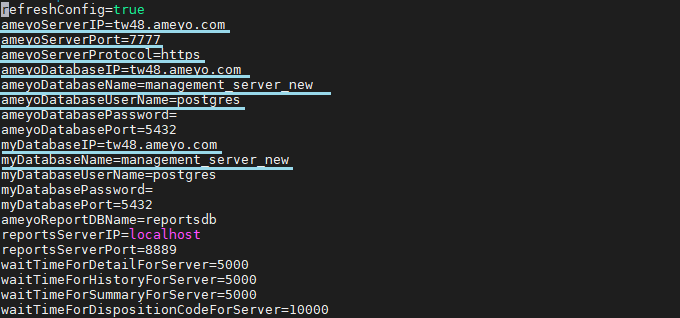Installation and Integration of Management Server User Interface
Perform the following steps to install and integrate the Management Server User Interface with Application server.
Execute the following command to install Management Server Interface. This application enables the Interface for Management Framework Architecture (MFA).
rpm -ivh <Management_UI_Server>.rpm

Figure: Install Management Server User Interface Application
Execute the following command to edit "Hibernate.properties" file of Management Server User Interface to provide the database connectivity into it.
vim /ameyo_mnt/dacx/var/ameyo/dacxdata/ameyo.management.server.ui.product/conf/hibernate.properties
Provide the details of the database for Management Interface
hibernate.connection.url jdbc:postgresql://<IP_of_Database>/<Database_Name_of_Management_Server_UI>
hibernate.connection.username <Database_User_Name>
hibernate.connection.password <Password_of_Database_if_any>

Figure: "Hibernate.properties" file of Management Interface
Execute the following command to edit "Tomcat.conf" file of Management Server UI to provide the SSL configuration for it.
This file needs to be modified only if, SSL is enabled with Ameyo.
vim /ameyo_mnt/dacx/var/ameyo/dacxdata/ameyo.management.server.ui.product/conf/tomcat.conf
Provide the following details of SSL in this file.
connector.https.secure=true
connector.https.httpsPort=<Management_UI_Port_Number>
connector.https.https=https
connector.https.SSLEnabled=true
connector.https.clientAuth=false
connector.https.keystoreFile=<Path_of_SSL_Keys><.jks_SSL_File>
connector.https.keystorePass=<SSL_Certificates_Password>
connector.https.keyAlias=<Alias_of_SSL_Certificates>
connector.https.SSLHonorCipherOrder=on
drishti.start.https.connector=true
The changes in the file are highlighted with blue-colored underline.

Figure: Tomcat.conf File of Management Server UI
Execute the following command to edit and provide the details of Management Server UI in "AmeyoManagementServerUI.ini" file.
vim /dacx/var/ameyo/dacxdata/ameyo.management.server.ui.product/conf/AmeyoManagementServerUI.ini
Copy and delete the following log file entry.
Xloggc:/dacx/var/ameyo/dacxdata/ameyo.management.server.ui.product/logs/gc-\$(date +%Y_%m_%d-%H_%M).log
The above log file entry is mandatory and needed. So before deleting this entry, keep it with you at safe place, as it has to be used later.
Execute the following command to provide the authentication to Management Server UI application in "ameyoconfig.props" file.
vim /ameyo_mnt/dacx/var/ameyo/dacxdata/ameyo.management.server.ui.product/conf/ameyoconfig.props
Provide the following Management Server information here.
ameyoServerIP=<Domain_Name_of_Server>
ameyoServerPort=<Management_Server_port_number>
ameyoServerProtocol=<Ameyo_Server_Protocol>
ameyoDatabaseIP=<Database_IP_or_Domain_Name>
ameyoDatabaseName=<Management_Server_Database_Name>
ameyoDatabaseUserName=<Database_User_Name>
ameyoDatabasePassword=<Database_Password_if_any>
ameyoDatabasePort=<Database_Port_Number>
myDatabaseIP=<Domain_Name_of_Server>
myDatabaseName=<Management_Server_Database_Name>
myDatabaseUserName=<Database_User_Name>
myDatabasePassword=<Database_Password_if_any>

Figure: Management Server UI AmeyoConfig.props File
Execute the following commands to start the Management Server and Management Server Interface
ameyoctl service ameyomanagementserverui start
Once the services of Management Server UI is started, now, execute the following command to provide "Xlog" entry in "AmeyoManagementServerUI.ini" file again.
vim /ameyo_mnt/dacx/var/ameyo/dacxdata/ameyo.management.server.ui.product/conf/AmeyoManagementServerUI.ini
Now, add the following Xlog entry again which you have deleted while configuring "AmeyoManagementServer.ini" file.
.Xloggc:/dacx/var/ameyo/dacxdata/ameyo.management.server.ui.product/logs/gc-\$(date +%Y_%m_%d-%H_%M).log
This is the same entry of "Xlog", that you have deleted earlier.

Figure: AmeyoMangementServerUI.ini File of Management Server
After adding the entry, now it is mandatory to restart Management Server and Management Server UI services again. Execute the following query to restart the services.
ameyoctl service ameyomanagementserverui stop
ameyoctl service ameyomanagementserverui start
You can contact Ameyo Support Team to get the above application RPM files.

Figure: AmeyoMangementServerUI.ini File of Management Server